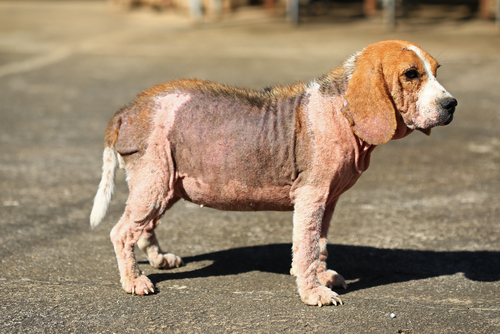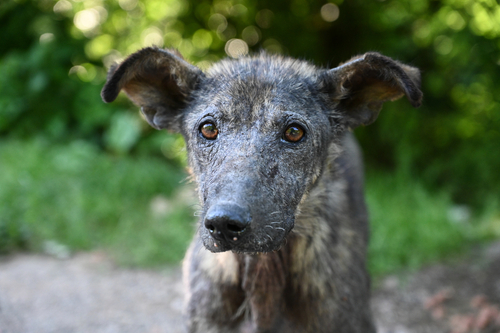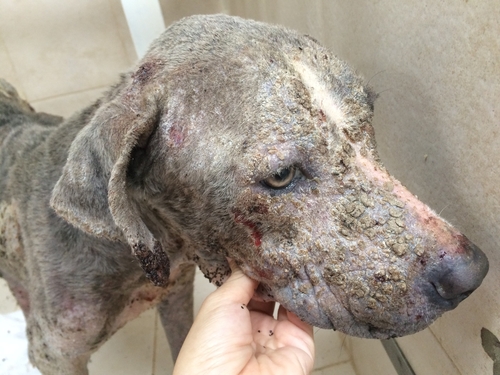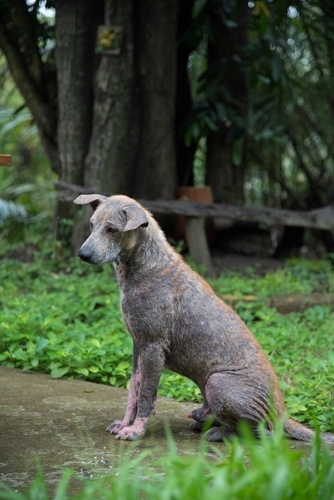What to Know About Mange in Dogs
Posted: 11/08/2022 | BY: Erin Cain | Categories: Dog , Health problems , Pet care
Mange is a skin condition caused by mites. It’s a common issue in dogs, and while it’s not usually serious, it can be very uncomfortable for your pup. There are two main types of mange: demodectic and sarcoptic, and dog owners should be wary of both. This blog post will focus on mange in dogs so dog parents can know what to look for and what to do if their dog gets it.

What is mange in dogs?
Mange is a skin disease caused by two different types of microscopic mites. Sarcoptic mange lives under the surface, while demodectic mange resides in hair follicles. Both forms of mange can cause dogs to develop painful body sores.
Demodectic mange, also known as demodicosis or red mange, is the most common type caused by the Demodex mite and is typically not contagious. Sarcoptic mange, on the other hand, is caused by the Sarcoptes scabiei mite and is highly infectious—not just to other dogs but to humans as well.
While both mites share similar characteristics, there are also significant differences. It is essential to distinguish between the two types of dog mange because they have different causes and treatments. Here are the two types of mange in dogs: symptoms, causes, and treatments.

Demodectic Mange
Symptoms of Demodectic Mange
Demodectic mange usually presents as one or more bald spots on your dog’s body. The hair may look thinned out or patchy, and the skin may be dry, red, and irritated. You may also notice your dog scratching or licking the affected areas more than usual.
Though it may seem like a dog with demodectic mange would constantly be itching, the truth is that some dogs can experience little to no irritation. The reason for this lack of discomfort? Their hair loss begins in only specific areas of your pup’s body, most commonly around the eyes and mouth. The dog may experience itchiness and pain when these patches become numerous enough.
If the mange is left untreated, it can lead to secondary infections and hair loss over larger body areas. In severe cases, demodectic mange can even cause death.
Causes of Demodectic Mange
All dogs have Demodex mites—these mites are part of a dog’s normal skin flora. However, puppies and immune-compromised dogs are more susceptible to developing an overgrowth of these mites, which leads to demodicosis (face mites). The exact cause of the overgrowth is unknown. Still, genetics seem to play a role since some breeds are more prone to developing demodicosis than others.
The breeds prone to demodectic mange are:
- American Staffordshire Terrier
- Australian Cattle Dog
- Bulldog
- Bull Terrier
- Cocker Spaniel
- Dachshund
- German Shepherd
- Great Dane
- Hubbard Shepherd
- Pug
- Shar-Pei
- Shih Tzu
- West Highland White Terrier
Having one of these dog breeds is not a guarantee that your dog will develop red mange, but it does mean you should keep a careful eye on your dog’s skin.
Treatment for Demodectic Mange
If your dog has demodicosis, don’t worry—it’s treatable! Your veterinarian will likely prescribe an antiparasitic medication to kill the mites. They may also recommend shampooing or dipping your dog in a medicated solution to soothe the skin and help speed up recovery.
In severe cases of demodicosis, where there is extensive hair loss or sores on the skin, your dog may need oral or injectable medications. With treatment, most dogs fully recover within 4-6 weeks.

Sarcoptic Mange
Symptoms of Sarcoptic Mange
Sarcoptic mange, also called canine scabies, is caused by an eight-legged mite called Sarcoptes scabiei that is too small to see with the human eye. This form of mange can be highly contagious and affects humans and dogs.
The scabies mite can be passed from dog to human, but it only thrives on canine hosts. A female parasite burrows into the skin where she lays eggs. After three weeks, those eggs hatch and feed on the dog’s skin.
Symptoms will generally appear 10-days to 8 weeks after contact with a dog carrying this infection. The first signs of infection usually appear on the body’s margins, including the belly, ears, elbows, chest, and hocks. Other common symptoms of sarcoptic mange include:
- hair loss
- redness and rash
- extreme itchiness
- yeast and bacteria infections
- thick yellow crusts
- skin thickening
- emaciation
- lymph node inflammation
The three last symptoms occur in highly advanced cases of scabies and mange.

Causes of Sarcoptic Mange
A dog can become infected with sarcoptic mange by being in direct contact with other infected dogs or wild canids, such as foxes and coyotes. If you think your dog has sarcoptic mange, it’s best to keep them away from other dogs, so they don’t spread the infection.
Kennels and shelters are high-stress, high-contact environments that increase the risk of contracting diseases like scabies. Stress can lower a dog’s immune system, making them more susceptible to parasites like this skin mite.
Treatment for Sarcoptic Mange
Treatment for dogs with sarcoptic mange is a variety of anti-parasite medications. Your veterinarian may recommend weekly lime sulfur dips, selamectin (Revolution), and fipronil Frontline treatments for this condition.
In some cases, your vet may suggest a systemic treatment. The most common oral drugs for this include selamectin (Revolution), imidacloprid-moxidectin (Advantage Multi), and off-label ivermectin use. Recently, some veterinarians have used the oral flea preventatives Bravecto and Nexgard as alternative scabies treatments.
With appropriate treatments, dogs with sarcoptic mange can make a full recovery. Treatments must be administered consistently, as the mite’s life cycle is 21 days. Recovery from scabies cases will take longer for dogs with severe cases.

Pet insurance can help you treat and prevent mange in dogs.
While most mange treatments are affordable, if your dog requires long-term treatment, that vet bill will add up fast. Don’t get caught having to choose between your bank account and your dog’s discomfort.
Get your pup a health insurance plan, starting with a free quote. Pet insurance will ensure that your dog has access to top veterinarians and treatment without hurting your bank account. Do yourself and your pup a favor and protect them with a health insurance plan today.
References:
- Dryden, M. (2022). Mite Infestation (Mange, Acariasis, Scabies) in Dogs. Retrieved from https://www.merckvetmanual.com/dog-owners/skin-disorders-of-dogs/mite-infestation-mange,-acariasis,-scabies-in-dogs
- O’Neill, D. (2020). Demodicosis in first opinion caseloads of dogs: the ‘mitey’ facts on frequency and breeds. Retrieved from https://www.veterinaryirelandjournal.com/small-animal/164-demodicosis-in-first-opinion-caseloads-of-dogs-the-mitey-facts-on-frequency-and-breeds#:~:text=Six%20breeds%20showed%20increased%20odds,than%20the%20adult%2Donset%20form.
- Wildlife Futures Team. (2020). Mange and Mites. Retrieved from https://www.vet.upenn.edu/research/centers-laboratories/research-initiatives/wildlife-futures-program/resources/fact-sheets/fact-sheet-detail/mange-and-mites
Disclaimer
The information contained on this blog is intended for informational and educational purposes only and should not be construed as medical advice. It is not a substitute for professional veterinary care. Always consult with your veterinarian before making any changes to your pet's health care or treatment plan.
The authors of this blog are not veterinarians and do not claim to be experts in pet health. The information provided here is based on our own experiences and research, as well as information from reputable sources. However, we cannot guarantee the accuracy or completeness of this information.
We encourage you to do your own research and consult with your veterinarian before making any decisions about your pet's health.
Next post
Ten Dog Breeds Most Prone to DiabetesCompare top pet insurance providers plans.
Enter your dog’s age in years and months to calculate their age equivalent to human years.
Calculate your dog’s ageEnter your cat’s age in years and months to calculate their age equivalent to human years.
Calculate your cat’s age